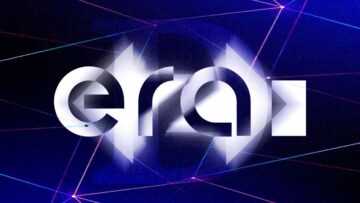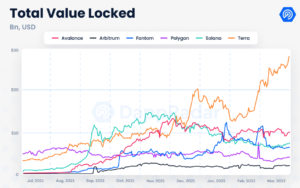A Step-by-Step Guide to the Blockchain Network Specializing in dApps and NFTs
Tezos is a unique blockchain network that paves the road for dApps, decentralized applications, which are powered by smart contracts. Although the same can be said of Ethereum, Tezos is ahead of the decentralized game thanks to its on-chain governance system.
Tezos token holders can vote on amending the network, without risking hard forks. This self-amending model also makes it easier to implement upgrades. Because of this flexibility, Tezos has attracted retail and institutional customers.
Tezos Purpose and Origin
Unlike most blockchain projects, Tezos started as a family venture by the couple Arthur and Kathleen Breitman. Arthur, a mathematician and veteran of whiteshoe investment banks Goldman Sachs and Morgan Stanley, came up with the idea in 2014.
Kathleen also worked in TradFi at the hedge fund Bridgewater, gaining valuable experience in distributed database systems. Arthur serves as Tezos’ Chief Technical Officer (CTO), while Kathleen is in the lead role as Chief Executive Officer (CEO).
Liquity Breaks DeFi Doldrums With ‘Chicken Bonds’ Offering
New Mechanism Quickly Amasses More than $5M in Deposits
They developed Tezos as a self-amending blockchain network that integrates voting. All XTZ token holders can vote for future network upgrades and rules. If the voting consensus is reached, the network automatically updates itself across all supporting nodes.
This on-chain governance practically eliminates a chance of a hard fork, which happens when a portion of miners/validators refuse to update their clients, so they continue as an offshoot of a new blockchain network. For this reason alone, Tezos has managed to consolidate its community. But not everything went smoothly during Tezos’ development.
Tezos Controversy
Following an initial coin offering in July 2017, Tezos was involved in a great deal of legal controversy. Amid litigation between various parties connected to the platform, the U.S. Securities and Exchange Commission ordered Tezos to pay a $24M civil penalty for failing to register the token offering executed during the ICO. In September 2020, Tezos investors settled the lawsuit for $25M, which was funded bythe Tezos Foundation.
Soon enough, the project gained momentum in the burgeoning NFT space. By February 2021, the largest NFT marketplace, OpenSea, announced Tezos integration.
What Makes Tezos Unique?
Like most networks supporting decentralized applications (dApps), Tezos employs a Proof-of-Stake (PoS) consensus. This way, it is more energy-efficient to run the network. Instead of new data blocks being added through computation-heavy mining, validators are randomly selected to generate new blocks (transactions).
For this energy-efficiency reason, PoS consensus has become a standard on networks that are bound to be heavily used through their dApps. Tezos tweaked PoS and turned it into a delegated PoS, or liquid PoS. Here is how it works:
[embedded content]
- Tezos has “bakers”, equivalent to Ethereum validators, to generate new data blocks.
- From a cluster of eligible bakers, Tezos algorithm picks a block-generating baker.
- Bakers with a higher amount of staked XTZ and better reputation have higher eligibility.
- When a baker generates a new block, it is sent to 32 other nodes, from within the bakers’ attestation pool.
Attestation is the process by which bakers test the block’s validity. If a new transaction passes it, the new block becomes a part of the Tezos blockchain. Both node network participants — bakers and attestors — receive an XTZ reward after a transaction successfully goes through.
Tezos has a slashing mechanism — if attesting nodes reject the block, the elected baker loses a portion of their stake. To become a Tezos baker, one has to wait 35 days to be approved.
Tezos On-Chain Governance
The Tezos network is designed so it’s not hard-coded. Instead, Tezos binary code hash is stored directly within the blockchain. This means that its executable layer is tied to the blockchain itself, allowing for on-the-fly changes.
This concept is groundbreaking because changing a network’s code is a time-consuming process. Case in point, when upgrading Bitcoin, by tweaking Bitcoin Core, much has to happen:
- Bitcoin developers have to reach a consensus.
- They need to persuade the community (miners) on new changes.
- If the community accepts, without much backlash, the changes are released as a package.
- Every miner running a full node (blockchain’s entire history) must then install the new upgrade and signal that it is upgraded to the network.
The same process applies to Ethereum and other networks, as they are both cumbersome and time-consuming. Tezos does away with it because bakers can propose changes as well, affecting any aspect of the network.
How Do Tezos Proposals Get Implemented?
Once the network proposal is announced, all registered XTZ stakeholders get to vote. With achieved consensus, as the 80% majority, all Tezos nodes receive the new hash as the updated source code. Therefore, the upgrade process is automatic, without nodes having to signal their status.
In technical terms, Tezos self-amending process takes 32 cycles, with each cycle taking three days. The entire proposal process is sectioned into four periods, consisting of eight cycles each:
- Proposal period
- Exploration vote period
- Testing period
- Promotion vote period
Altogether, this filtering and testing mechanism lasts for about three months. The history of all amendments is available on OpenTezos.
Tezos XTZ Token
Unlike Bitcoin, XTZ supply is not limited, consisting of over 910M XTZ. Although bakers can vote on implementing such a cap, in the present state, XTZ tokens have an inflation rate of about 5%.
When the controversial Tezos ICO was launched, 80% of XTZ tokens went to investors, with the rest evenly distributed between Dynamic Ledger Solutions and the Tezos foundation. At its highest price point, XTZ reached $9.18 in October 2021.
[embedded content]
In July 2022, TezDev conference announced WASM and EVM optimistic rollups, theoretically enabling the network to reach 1M tps. For comparison, Ethereum’s post-Merge tps is 14 on average. Outside of that massive milestone, Tezos has 135 other projects, indicating steady adoption across all DeFi categories.
Tezos has an exceedingly flexible foundation. Even if there is a flaw present in its current configuration, it can be addressed through a streamlined process. For this reason alone, Tezos investors tend to place a long-term bet, instead of seeking short-term returns.
Series Disclaimer:
This series article is intended for general guidance and information purposes only for beginners participating in cryptocurrencies and DeFi. The contents of this article are not to be construed as legal, business, investment, or tax advice. You should consult with your advisors for all legal, business, investment, and tax implications and advice. The Defiant is not responsible for any lost funds. Please use your best judgment and practice due diligence before interacting with smart contracts.
- Bitcoin
- blockchain
- blockchain compliance
- blockchain conference
- coinbase
- coingenius
- Consensus
- crypto conference
- crypto mining
- cryptocurrency
- decentralized
- DeFi
- Digital Assets
- ethereum
- machine learning
- non fungible token
- plato
- plato ai
- Plato Data Intelligence
- Platoblockchain
- PlatoData
- platogaming
- Polygon
- proof of stake
- The Defiant
- W3
- zephyrnet










